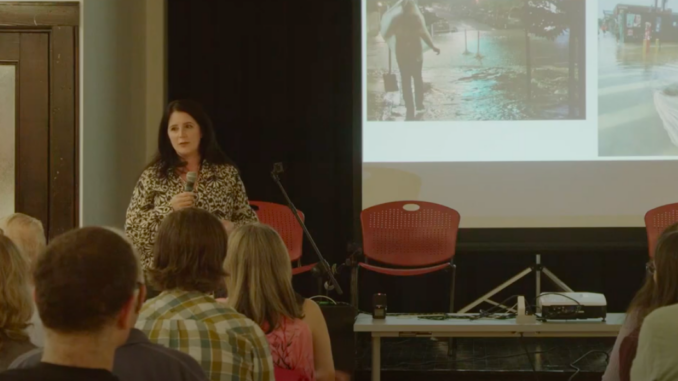
BY CAITLYN JONSSON
Park Slope resident Joann Amitrano lives in a state of anxiety when it comes to the increased risk of flooding in the neighborhood, regularly checking the chance for heavy rain across multiple weather apps. If her fears are confirmed, she attempts to protect her home by using wooden boards to seal the entrances. In 2023, Brooklyn saw 18 flash flood emergencies, the most flooding the borough has experienced in the past decade, according to Emergency Management’s Hazard History and Consequences tool. Flash floods are caused by heavy rainfall, a weather event that is increasing in frequency and intensity due to the warming atmosphere from climate change.
On October 1st, residents in Park Slope and surrounding Brooklyn neighborhoods came together in the Park Slope Public Library to discuss their concerns about the increased threat of flash floods. The conversation was co-hosted by The City Sponge, Forth on Fourth Ave, Gowanus Canal Conservancy, and Park Slope Civic Council. Representatives from the Department of Environmental Protection and the Office of Emergency Management were also present to offer expertise.
Andrea Parker, executive director of the Gowanus Canal Conservancy, underlined that Park Slope is geographically oriented on a hill that extends down into Gowanus, which used to be a salt marsh fed by streams. “The ecology underneath us asserts itself constantly,” said Parker, explaining that it increases flooding vulnerability throughout the neighborhood. Heavy rain that hits 8th Avenue drains downward to 4th Avenue, increasing the flooding vulnerability for residents at the bottom of the hill and nearby Gowanus.
Parker urged homeowners on higher land to take action by adopting permeable spaces in their yards and on roofs to help absorb stormwater. “We need a lot more uphill solutions,” or downhill issues are going to get worse, she added. Homeowners can implement green spaces such as rain gardens and green roofs, which can reduce the amount of stormwater runoff by up to 90%.
Amitrano, who lives at the bottom of the slope on 4th Avenue, highlighted that experiencing these flooding risks takes a toll both on her physical and emotional well-being. “Just talking about floods gives me so much anxiety… any time I see the weather forecast that something terrible’s on the way I actually get sick, I get neurotic,” said Amitrano.
Tara Deighan, the Director of Strategic Planning for NYC’s Department of Environmental Protection, highlighted the importance of green infrastructure in flooding prevention, stating that “it reduces sewer overflows, cleans the air, and cleans neighborhoods.” Deighan added that the city is undertaking a project to install porous pavement in Park Slope and Gowanus, which are concrete panels that can absorb rainwater into underlying soil.
Despite experiencing a rise in flooding, residents in Park Slope exist within “communities of privilege,” according to Jill Cornell, a Community Engagement Specialist with NYC’s Emergency Management Department. In 2022, the median household income in Park Slope was 109% higher than the citywide median, with a poverty rate 50% lower than citywide levels. Additionally, the neighborhood has a predominantly White population of 62.5%, compared to 30.9% citywide.
“The challenge for us as neighbors and community members is to figure out what is our role in inserting equity into our mitigation and our preparedness,” said Cornell, as not all residents have access to the same resources. Equity, according to Cornell, can look like homeowners who live at the top of the hill prioritizing the installation and inclusion of greenspaces on their property. Additionally, residents can get to know their neighbors, as they may live near someone who could benefit from extra support.
Councilmember Shahana Hanif, the representative for District 39 which includes Park Slope, highlighted the importance of looking at the flooding concerns from a broader perspective, as the issue is not isolated to the Park Slope community but extends throughout Brooklyn. Hanif said that there is a lack of legislation on the city level for flood mitigation, and that is one area where she is looking for legislative opportunities, as “the solution can’t just be house by house.”
